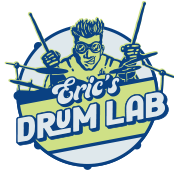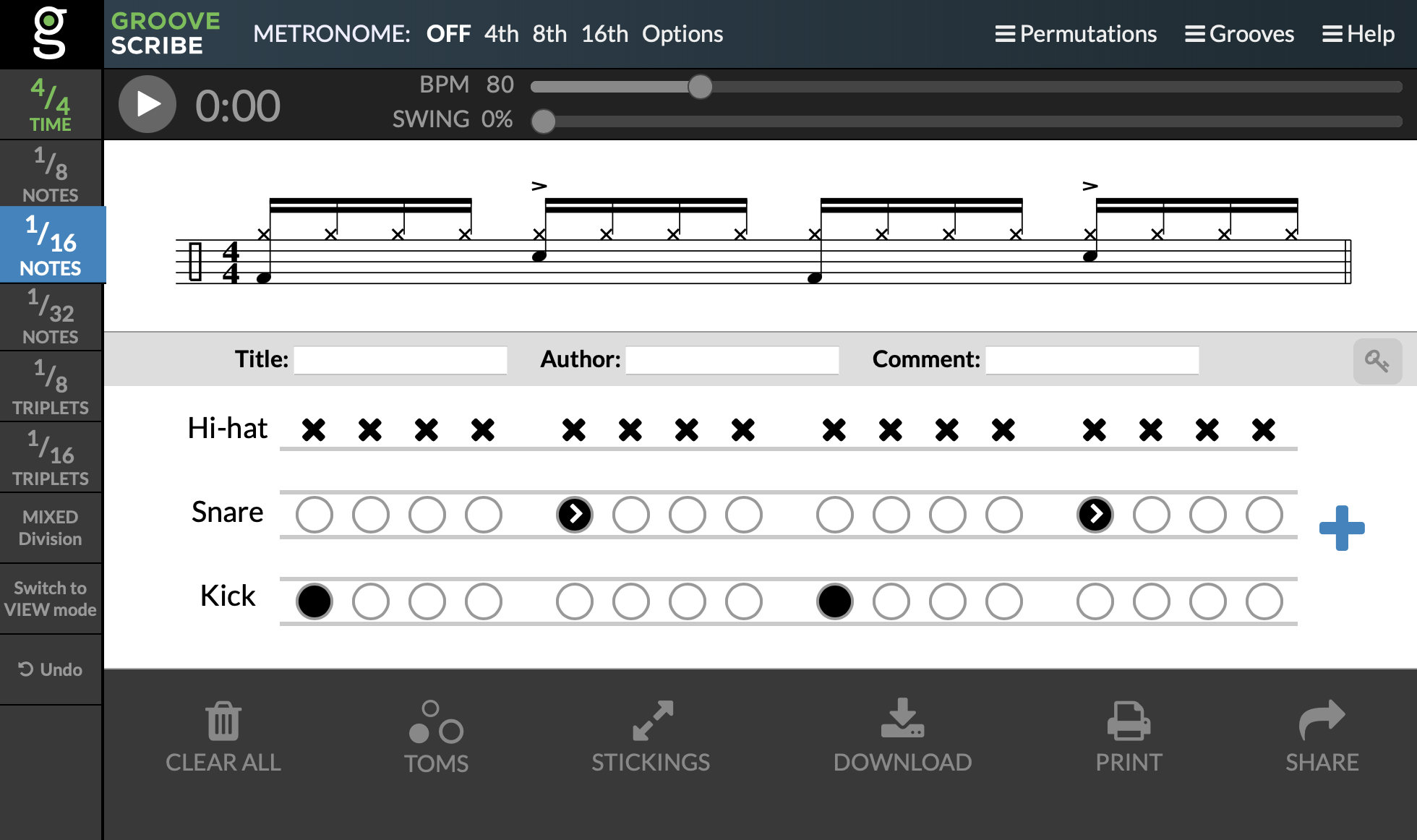Drumming Supplies
You only need a few tools to get started drumming: drum sticks, a practice pad, a stand for your practice pad and maybe a couple drumming method books. You might be thinking that playing on a practice pad doesn't sound very fun or exciting, but I believe that once you get started, and you have a few exercises to work on, you'll realize it's actually pretty fun AND beneficial. Every minute you invest on the practice pad will pay off when you sit down at the drum set.
So if you're ready to get started drumming, I have a few recommendations. First of all, I highly recommend visiting your local drum shop or music store for all your drumming supplies before buying online. Support your local businesses! If that's not possible, then here are a few links.
Full disclosure: As an Amazon Associate, I earn a commission from qualifying purchases. Thanks!
Drum Sticks
First item on the list is drum sticks. Vic Firth is probably the most popular brand. There's also ProMark, Vater, Meinl, and the list goes on. As far as size goes, I recommend 5A (a good, general size) to start with, and I prefer wooden tips. Again, if you can get to your local drum shop and try out some sticks, that'd be best, but you can't go wrong with any of these.
Practice Pad
I must admit I have way too many drum practice pads; all different sizes and materials. It's a problem, lol. The one I'm recommending, the Evans "Real Feel" is a pretty standard model. I haven't tried the other brands, so your mileage may vary... Make sure to buy the 12", not one of the smaller ones. And don't bother getting the double-sided version. You'll most likely never use the flip side.
The practice pad might seem a little expensive, compared to a pair of drum sticks, but keep in mind you'll use it for years. My primary practice pad is one I bought in 1988! Money well spent.
A word to the wise... You may see offers that include a pair of drumsticks. Those sticks are usually made from cheap, light wood, and will likely end up in the trash, so don't let that "deal" influence your purchase.
Practice Pad Stand
Just buy the cheapest stand you can find! At the moment, the LOLUNUT (who names these things?!) was the best deal on Amazon. There are also several deals that include the practice pad, sticks, gels, cases... Keep in mind that you'll never use the gels (those are for actual drums), probably won't use the cases, and the drumsticks will be pretty poor quality, so if you do go for one of the deals, definitely get some name brand sticks as well.
Drumming Books
There are so many great drumming books out there, both classic and modern. I'll list a few that get used here in the studio nearly every day of the week.
A Funky Primer - Charles Dowd
Ah, the Funky Primer! I believe this was my very first drum set method book… I still have my tattered copy from the 1980’s!
This book is primarily for beginning and intermediate drummers, but I regularly repurpose pages of this book to make it challenging even for advanced drummers. The first few sections cover basic notation reading and practically every 8th-note variation that can be played on the kick drum, then delves into 16th-note grooves and exercises, and even some 16th-note triplet exercises, very John Bonham-like.
Although Funky Primer is an older book, it's still musically relevant, and is required for all my beginning students. It's a great book to start your drumming journey.
Teaching Rhythm for all Instruments - Joel Rothman
This is an excellent source for learning to read rhythmic notation. Around here we just call it "Rothman," and it's a requirement for all beginning drum students. Mr. Rothman presents the material in such a simple and logical way, that my students can literally read music from day one. The lessons become progressively more interesting and challenging as we move from quarter notes to 8th notes, 16th notes, triplets, etc. Honestly, my kids really love working from this book.
Great Hands for a Lifetime - Tommy Igoe (DVD)
This is one of my all-time favorite drum education products, and I use it both in my teaching practice and as a life-long student of drumming myself. It’s essentially a guided sequence of snare drum rudiments all seamlessly connected by a double-stroke roll. It makes for a great warmup and is fun to play.
The product contains notation, guided mp3 play-alongs, and an instructional DVD. The DVD is very helpful for developing proper hand technique and to see and hear how the various rudiments should be played. I play along to the Advanced mp3 every day, which I still find challenging. There are 3 versions of the exercise, called Basic, Intermediate, and Advanced. To be honest, the “Basic” version is too difficult for beginners. It presumes the ability to play a double-stroke roll at 130 BPM. Beginners can, however, still learn the rudiments and play through the piece at their own metronome setting; they just won’t be able to play along to the guided mp3 until they’ve reached a higher level of proficiency.
The Intermediate and Advanced versions are progressively more difficult (and fun!), as additional rudiments and combinations are added, and the tempo is increased.
I highly recommend Great Hands for a Lifetime. It’s my go-to daily warmup.
The Language of Drumming - Benny Greb
This book fills in some of the gaps left by other drumming method books. It systematically covers every 16th-note and 8th-note triplet rhythm, played as individual rhythms then as accents, flams, and diddles across full bars of 16th notes or triplets. The initial exercises are the type of thing one might learn, like I did, in a drum line situation.
Once you have a handle on the core 16th-note and triplet rhythms, Benny then applies them to the drum set as grooves. From there you can get into pretty deep water experimenting with passing the core rhythms through different hand/foot ostinatos (that you create), which can result in some very complex grooves. The book also delves into odd groupings, linear drumming and more. Tbh, I'll be working out of this one for a few more years.
The Art of Bop Drumming - John Riley
If you have any interest in playing jazz, you'll need this book. It begins with the basic ride cymbal pattern, then introduces simple "comping" patterns on the snare, then more complex patterns. It has helpful play-alongs you can download. It touches on soloing and phrasing, playing with brushes, introduces a few Latin grooves, talks about reading a lead sheet, and has a nice little "Recommended Listening" section at the end. Seriously, if you're thinking about jazz, just buy this book. Once you finish it, continue with more Riley books. They are superb.
Online Drumming Resources
I'd be remiss if I didn't mention some of the online resources that I use, both as a teacher and a lifelong student.
Drumeo
You might be wondering, "Why would a private drum instructor recommend an online lesson site? Isn't that direct competition?!"
Well, it is and it isn't. Nothing compares to one-on-one instruction, but Drumeo (and other sites) offer lots of supplemental material to work on, and you can see video lessons from very famous drummers who would otherwise be unavailable to us.
Drumeo also offers drum transcriptions of literally thousands of songs across most musical genres. Honestly, the transcriptions are the big selling point for me, and why I'm an annual subscriber myself.
Roughly 80% of my students subscribe to Drumeo, mainly to take advantage of the song transcriptions. Clicking the image here will allow you to register for a free 30 day trial. I am a Drumeo affiliate, so if you do signup, I make a small commission. Thanks.















